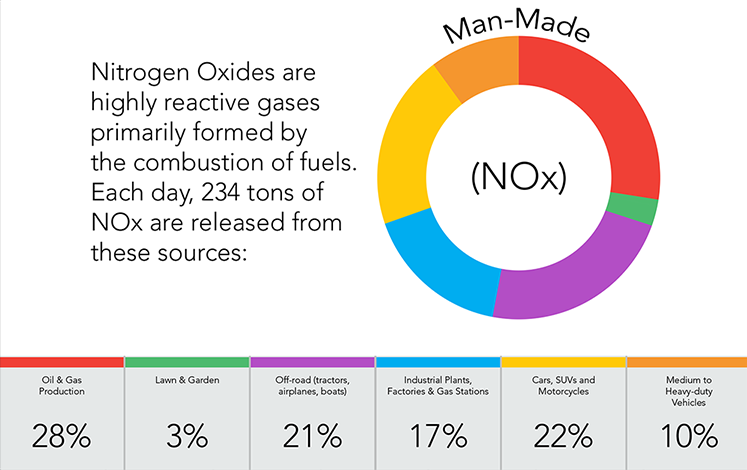Pollutants We Are Combating
Air Quality Toolkit for Local Governments
Ground-Level Ozone: The Area’s Biggest Air Quality Concern
Ground-level ozone is formed when Volatile Organic Compounds (VOCs) and Nitrogen Oxides (NOx) combine and “cook” in the heat and sunlight. The highest ozone levels are usually recorded in summer months on hot, stagnant days with little wind.
Why is it bad?
Unlike the good, protective ozone layer in the stratosphere, ground-level ozone is a harmful air pollutant that affects all of us – particularly the young and elderly. Those who are active and exercising outdoors may experience breathing difficulties and eye irritation. Prolonged exposure may result in reduced resistance to lung infections and colds. Ozone can also trigger attacks and symptoms in individuals with pre-existing conditions such as asthma, or other respiratory diseases like chronic bronchitis and Chronic Obstructive Pulmonary Disease (COPD).
Pollutant Status:
The nine-county Denver Metro/North Front Range Area is out of compliance with federal air quality standards for ozone. RAQC-sponsored projects such as Clean Air Fleets, Mow Down Pollution and the Simple Steps. Better Air. campaign aim to reduce ozone-causing emissions.
Where Ground-Level Ozone Comes from in Colorado
 |
 |
Carbon Monoxide (CO)
Carbon Monoxide is a colorless, odorless gas that is formed from the incomplete burning of fuel (combustion). It is emitted directly into the air from vehicle exhaust pipes and typically occurs when vehicles are first started up or when they are not properly started.Why is it bad? Carbon Monoxide reduces oxygen delivery to the body’s organs and tissues.
Pollutant status:
While the region is not in violation of CO standards, the RAQC has several programs in place to help reduce vehicle emissions and keep this pollutant in check.
Particulate Matter
Particulate matter (PM) consists of airborne particles that can be inhaled by humans. PM comes in sizes ranging from 2.5 to 10 micrometers in diameter.Why is it bad? Recent Environmental Protection Agency (EPA) studies suggest that PM is harmful to human health because small particles less than 10 micrometers in diameter are too small to be filtered by the nose and lungs and can get deep into the lungs and into the bloodstream. Particle pollution exposure has been linked to serious health problems involving the lungs and heart.
PM 2.5
PM 2.5 is fine particulate matter measuring only 2.5 micrometers. It is so small that it can be detected only with an electron microscope. PM 2.5 is created from combustion processes, including those from motor vehicles, power generation, residential wood burning, forest fires, agricultural processes and some industrial processes.
Pollutant status:
The Denver metro region is currently in compliance with PM 2.5 standards. The RAQC’s Clean Air Fleets program aims to reduce PM 2.5 levels in the region.
PM 10
PM 10 is coarse particulate matter measuring between 2.5 micrometers and 10 micrometers. PM 10 is created from windblown dust, unpaved roads, street sand, and crushing and grinding operations.
Pollutant status:
The Denver metro region has been in compliance with PM 10 standards since 1993. RAQC-sponsored projects such as wood-burning fireplace/stove change out and street sweeping programs have helped the region to lessen PM 10 and, therefore, reduce the amount of particles contributing to the “Brown Cloud” in the winter.

